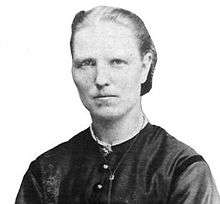Anne Hov
Anne Hov (ca. 1846-ca. 1935) was a farm wife from Gudbrandsdalen. She has been credited with developing the modern version of the Norwegian cheese brunost.[1][2]
Anne Hov | |
|---|---|
 | |
| Born | c. 1846 Oppland, Norway |
| Died | c. 1935 Oppland, Norway |
| Nationality | Norwegian |
| Spouse(s) | Tor Olsen Hov |
| Awards | King's Medal of Merit in silver |
Biography
Anne Olsdatter, the daughter of Ola Kvålen and Kari Olsdatter, was raised on the Solbrå (Solbråsetra) farm in the parish of Nord-Fron in the valley of Gudbrandsdalen in Oppland.[3]
Traditionally brunost was made on farms throughout Norway by boiling whey without the addition of milk or cream. This became a sugar rich, lean product. While working at a mountain farm near Gålå during 1863, Hov came up with the idea of adding cream to cow-milk whey and to boil it down in an iron pot until the fluid content was reduced, creating a firmer, fatty, more cheese-like product. She originally called it Feitost ("Fat Cheese"). The product immediately caught on, and was soon commonly produced and consumed in the area. The name was later changed into Fløtemysost ("Cream Whey Cheese") and this variety is currently a popular type of cheese.[4][5] [6] [7]
In the second part of the 1800s, Gudbrandsdalen was suffering economically due to falling profits from grain and butter sales. When Anne Hov married Tor Olsen Hov and moved to Rusthage (Rusthågå) in Nord-Fron, she started larger-scale cheese production and invented a variety where she added goat's milk to the mix for a more pronounced taste. The local trader Ole Kongsli liked it so much he thought there might be a market for the product in Oslo. Ole Kongsli started exporting it to his business contacts in Oslo under the name Gudbrandsdalsost ("Gudbrandsdal Cheese"), and it became so successful that it contributed significantly to the economy of the region, thus helping Gudbrandsdalen out of recession.[8] [9] [10][11]
In 1933, aged 87, Anne Hov received the King's Medal of Merit (Kongens fortjenstmedalje) in silver for her contributions to Norwegian cuisine and economy.[12][13]
See also
References
- Rebecca Dinerstein (June 11, 2015). "Ode to Norwegian Brown Cheese". The New Yorker. Retrieved April 1, 2018.
- Jan Peter Aursnes. "brunost". Store norske leksikon. Retrieved April 1, 2018.
- "Solbrå (73) Nord-Fron herad, Oppland". Matrikkelutkastet av 1950. Retrieved April 1, 2018.
- "Solbråsetra". Norsk kulturarv. Retrieved April 1, 2018.
- "Solbrå, Sør-Fron herad, Oppland". Matrikkelutkastet av 1950. Retrieved April 1, 2018.
- Mia Hayat. "History of Brunost". Antioch University. Retrieved April 1, 2018.
- "Fløytemysost". Bokmålsordboka (University of Bergen). Retrieved April 1, 2018.
- "Rusthage. Nord-Fron herad. Oppland". Matrikkelutkastet av 1950. Retrieved April 1, 2018.
- "Anne Hov oppfant Gudbrandsdalsosten". Gudbrandsdalsost. Retrieved April 1, 2018.
- "Gudbrandsdalsosten og Anne Hov". www.otta2000.com. Retrieved 2016-10-16.
- "Brunost Blessings". The Norwegian American. December 29, 2017. Retrieved April 1, 2018.
- "'Brunost' – Brown Cheese, A Scandinavian Specialty". ThorNews. 2012-01-06. Retrieved 2016-10-16.
- "Kongens fortjenstmedalje". lokalhistoriewiki.no. Retrieved April 1, 2018.